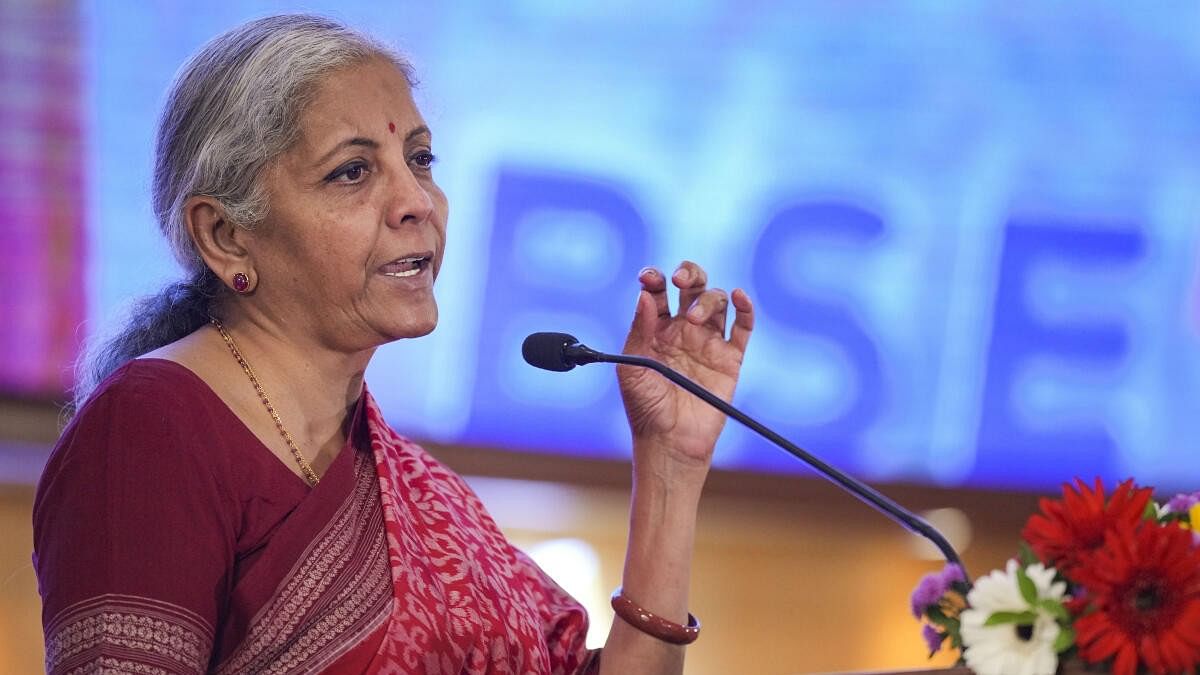
Nirmala Sitharaman speaks during the 'Viksit Bharat 2047' event at BSE, in Mumbai.
Credit: PTI Photo
As India marches towards its ambitious goal of becoming a ‘Viksit Bharat’ by 2047, a critical challenge threatens this vision: the ongoing exodus of its brightest minds. The Union Budget for 2025-2026 must address this issue head-on if we are to transform the dream of a developed India into a reality. Will India rise to the challenge?
‘Viksit Bharat’ represents India’s goal of becoming a global powerhouse by 2047, with a strong economy, advanced infrastructure, and equitable society. As of 2023, India is the world’s fifth-largest economy, with a gross domestic product (GDP) of over $3.7 trillion.
The country has achieved an average GDP growth rate of 6.5%, making strides in sectors like IT, pharmaceuticals, and space research.
To reach the $10 trillion economy milestone by 2030, India needs to maintain an annual growth rate of over 8%. Innovation, powered by skilled professionals, is key to this growth. But the growing brain drain threatens to derail this trajectory. Can India realise its ambition without retaining its best minds?
India has long faced the challenge of brain drain, and the trend continues to escalate. Between 2015 and 2022, 1.3 million Indians left the country, many of whom were highly educated professionals. In 2022 alone, 225,000 Indians renounced their citizenship, the highest number recorded. The United States, Canada, and Europe remain top destinations for these skilled workers.
This loss of talent is not just about numbers but the economic potential that leaves with them. The information technology sector, contributing 7.5% to India’s GDP, is a prime example. Experts estimate India’s IT industry could have added $15-20 billion more annually had the talent stayed. The sector could contribute $1 trillion to the economy by 2030, but brain drain jeopardises that potential.
The 2025-2026 Union Budget offers an opportunity to address the root causes of brain drain. Retaining talent and encouraging the return of Indian professionals abroad should be a priority. Key areas of focus include:
Education and Research Funding: India spends 3.1% of its GDP on education, below the global average of 4.9%. Increasing this to 5% would help bridge the gap. Allocating Rs 1 lakh crore ($12 billion) for research and development, up from the current Rs 50,000 crore, would build world-class institutions and prevent talent from leaving for greener pastures.
Startup Ecosystem and Innovation: India’s startup ecosystem is booming, with over 90,000 startups contributing $400 billion to the economy. However, retaining talent requires further support. Doubling the Fund of Funds for Startups (FFS) from Rs 10,000 crore ($1.2 billion) to Rs 20,000 crore ($2.4 billion) and establishing innovation hubs in smaller cities could reduce the allure of foreign jobs.
Public-Private Partnerships: Collaboration between the public and private sectors is crucial for innovation in fields like AI, biotechnology, and clean energy. In 2023, India attracted $25 billion in FDI in these areas. The budget could allocate Rs 50,000 crore ($6 billion) to foster partnerships between academia and industry, ensuring India remains competitive globally.
Taxation and Financial Incentives: To encourage the return of skilled professionals, the government could introduce tax breaks for returning NRIs and offer reduced tax rates on income from patents developed in India. A 10-year tax exemption on intellectual property income could be a powerful incentive to bring talent back home.
The consequences of brain drain extend beyond economic losses. The exodus of skilled professionals affects the aspirations of younger generations, who may see more opportunities abroad. If India cannot provide an environment where talent can thrive, the vision of Viksit Bharat will remain unattainable.
Moreover, global competition for talent is intensifying. Countries like the US and Canada actively recruit Indian professionals with attractive immigration policies. In 2022, the US issued over 65,000 H-1B visas to Indians, accounting for 75% of the total. If India fails to act, it risks losing its competitive edge in the global race for talent.
The Union Budget for 2025–26 is not just a financial plan—it’s a roadmap for India’s future. Addressing brain drain is not only about preventing people from leaving but about creating an environment where they want to stay. By fostering a culture of innovation, investing in education, and providing financial incentives, India can retain its talent and attract those who have left.
As India approaches 2047, the decisions made today will shape the nation’s future. With the right fiscal policies, India can retain its best minds, realise the vision of Viksit Bharat, and solidify its position as a global leader.
(The writers are with NCAER, New Delhi)